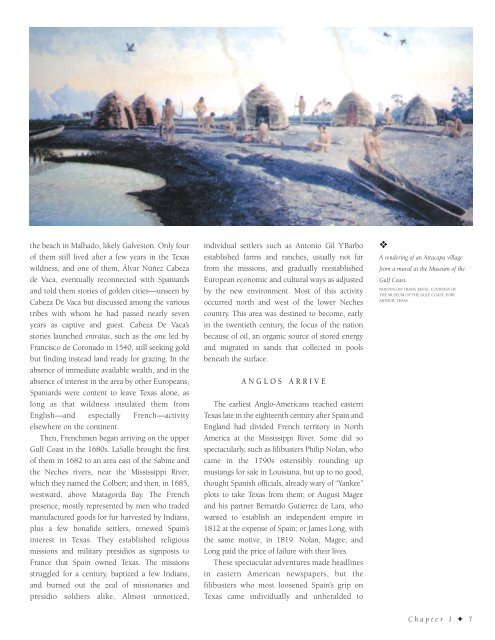Water Rails & Oil - Historic Mid & South Jefferson County
An illustrated history of the Mid and South Jefferson County area, paired with the histories of companies, families and organizations that make the region great.
An illustrated history of the Mid and South Jefferson County area, paired with the histories of companies, families and organizations that make the region great.
You also want an ePaper? Increase the reach of your titles
YUMPU automatically turns print PDFs into web optimized ePapers that Google loves.
the beach in Malhado, likely Galveston. Only four<br />
of them still lived after a few years in the Texas<br />
wildness, and one of them, Álvar Núñez Cabeza<br />
de Vaca, eventually reconnected with Spaniards<br />
and told them stories of golden cities—unseen by<br />
Cabeza De Vaca but discussed among the various<br />
tribes with whom he had passed nearly seven<br />
years as captive and guest. Cabeza De Vaca’s<br />
stories launched entratas, such as the one led by<br />
Francisco de Coronado in 1540, still seeking gold<br />
but finding instead land ready for grazing. In the<br />
absence of immediate available wealth, and in the<br />
absence of interest in the area by other Europeans,<br />
Spaniards were content to leave Texas alone, as<br />
long as that wildness insulated them from<br />
English—and especially French—activity<br />
elsewhere on the continent.<br />
Then, Frenchmen began arriving on the upper<br />
Gulf Coast in the 1680s. LaSalle brought the first<br />
of them in 1682 to an area east of the Sabine and<br />
the Neches rivers, near the Mississippi River,<br />
which they named the Colbert; and then, in 1685,<br />
westward, above Matagorda Bay. The French<br />
presence, mostly represented by men who traded<br />
manufactured goods for fur harvested by Indians,<br />
plus a few bonafide settlers, renewed Spain’s<br />
interest in Texas. They established religious<br />
missions and military presidios as signposts to<br />
France that Spain owned Texas. The missions<br />
struggled for a century, baptized a few Indians,<br />
and burned out the zeal of missionaries and<br />
presidio soldiers alike. Almost unnoticed,<br />
individual settlers such as Antonio Gil Y’Barbo<br />
established farms and ranches, usually not far<br />
from the missions, and gradually reestablished<br />
European economic and cultural ways as adjusted<br />
by the new environment. Most of this activity<br />
occurred north and west of the lower Neches<br />
country. This area was destined to become, early<br />
in the twentieth century, the focus of the nation<br />
because of oil, an organic source of stored energy<br />
and migrated in sands that collected in pools<br />
beneath the surface.<br />
ANGLOS<br />
ARRIVE<br />
The earliest Anglo-Americans reached eastern<br />
Texas late in the eighteenth century after Spain and<br />
England had divided French territory in North<br />
America at the Mississippi River. Some did so<br />
spectacularly, such as filibusters Philip Nolan, who<br />
came in the 1790s ostensibly rounding up<br />
mustangs for sale in Louisiana, but up to no good,<br />
thought Spanish officials, already wary of “Yankee”<br />
plots to take Texas from them; or August Magee<br />
and his partner Bernardo Gutierrez de Lara, who<br />
wanted to establish an independent empire in<br />
1812 at the expense of Spain; or James Long, with<br />
the same motive, in 1819. Nolan, Magee, and<br />
Long paid the price of failure with their lives.<br />
These spectacular adventures made headlines<br />
in eastern American newspapers, but the<br />
filibusters who most loosened Spain’s grip on<br />
Texas came individually and unheralded to<br />
❖<br />
A rendering of an Attacapa village<br />
from a mural at the Museum of the<br />
Gulf Coast.<br />
PAINTING BY TRAVIS KEESE. COURTESY OF<br />
THE MUSEUM OF THE GULF COAST, PORT<br />
ARTHUR, TEXAS.<br />
Chapter I ✦ 7
















